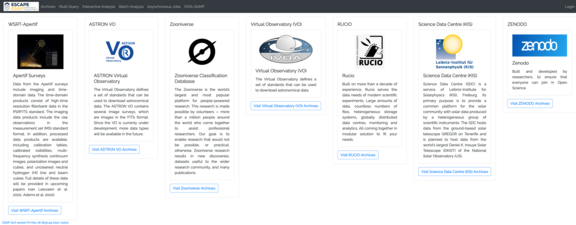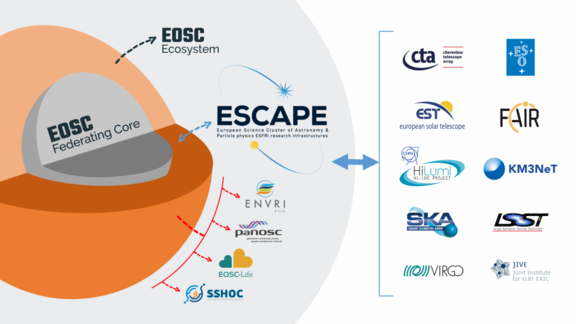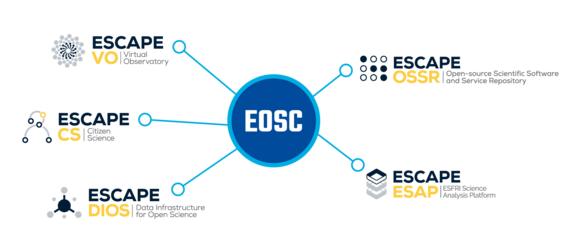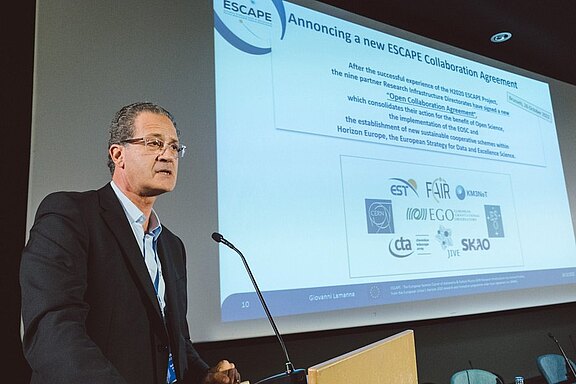The European Science Cluster of Astronomy & Particle physics ESFRI (ESCAPE) funded by the EU Horizon2020 Programme (https://projectescape.eu/) has put together a cluster of ESFRI (European Strategy Forum on Research Infrastructures) projects, including the European Solar Telescope (EST, https://www.est-east.eu/), which have faced challenges in data-driven research, demonstrated capabilities in addressing various stages of data workflow and carried out fundamental research through complementary approaches.
ESCAPE was founded to produce versatile solutions, with great potential for discovery, and to support the implementation of the EOSC, thanks to open data management, cross-border and multi-disciplinary open environment, according to the FAIR (Findable, Accessible, Interoperable and Reusable) principles. The ESCAPE works towards enabling interoperability between the facilities, minimising fragmentation, encouraging cross-fertilisation and developing joint multiwavelength/multi-messenger capabilities in astronomy, astrophysics and particle astrophysics communities. This is pursued through the five main ESCAPE services: the Virtual Observatory (VO), the Open-source Scientific Software and Service Repository (OSSR), Citizen Science (CS), the ESFRI Science Analysis Platform (ESAP) and the Data Infrastructure for Open Science (DIOS). Thus, the ESCAPE has been buit upon the capacities created by the H2020 ASTERICS (2014-2018, https://www.asterics2020.eu/) project, to which KIS/SDC also contributed as the EST representative.
KIS/SDC Contribution to the ESFRI Science Analysis Platform (ESAP) service. KIS/SDC has expanded beyond the solar user community to the broader astronomical and particle physics community by providing access to high-resolution solar data from the GREGOR, Vacuum Tower Telescope (VTT) and ChroTel telescopes (operated by KIS on behalf of German partners) via the SDC archive now included in the ESAP Service.
KIS/SDC Contribution to the Virtual Observatory (VO) service. KIS/SDC, together with the Royal Observatory of Belgium and in collaboration with the Strasbourg astronomical Data Center (CDS) and the German Astronomical Virtual Observatory (GAVO) have provided access to the broader Astronomical community within ESCAPE and beyond to solar data from ground- and space-based observatories with the integration of these data into the VO Service by making the data compliant with the International Virtual Observatory Alliance (IVOA) metadata standards. VTT and ChroTel data are now also available via the EPN-TAP service and are accessible using the various clients.
ESCAPE to the Future. At the final “ESCAPE to the Future” all-hands event in Brussels on October 25-26 (2022, https://projectescape.eu/events/escape-future) with participation of KIS/SDC, the members of the cluster shared their results and achievements, and discussed the future of the ESCAPE Collaboration.
After the successful experience of the ESCAPE Horizon2020, the nine core ESCAPE Research Infrastructure partners including EST have signed a new Open Collaboration Agreement, which consolidates their cross-border action for the benefit of Open Science, the implementation of the EOSC and the establishment of new sustainable cooperative schemes within the Horizon Europe Programme for the benefit of the European Strategy for data and excellence science. The agreement is also open to further research infrastructures to join. This agreement is expected to maintain the collaborative and scientific experience represented by the Science Cluster and strengthen the role and impact of astronomy and nuclear/particle physics in the field of open science and, more broadly, in the European Research Area. KIS/SDC envisages to represent the EST community and advance the integration of solar data within this endeavour.



